| ID |
Date |
Author |
Category |
Subject |
Year |
|
21
|
Thu Aug 29 10:02:22 2019 |
Jan | Detectors | bakeout at ESR setup | |
The bakeout for our detector setup has started on the evening of 27.08.2019
We have a temperature sensor in the vacuum next to the detector.
The goal is to maximize bakeout temperature, while not going above 125°C at the detector/sensor.
Here is a daily protocol of temperatures and vacuum pressure
T_12 is the set value of the 1st and 2nd controller device
T_34 is the set value of the 3rd and 4th controller device
T_56 is the set value of the 5th and 6th controller device
T_sens is the temperature measured by the sensor close to the detector
day date P_setup T_sens T_12 T_34 T_56 comment
1 tue 28.08. 1e-6 mbar ~100° ~120° ~120° ~120° carefull start
2 wed 29.08. 3e-7 mbar ~121° ~180° ~150° ~150° T_sens reached ~126° during NEG-pump conditioning
3 thu 30.08. 6e-7 mbar ~124° ~185 ~150° ~175° readjusted T_56, outgassing a bit increased
7 mon 02.09. 5e-9 mbar ~80° during cooldown
9 wed 04.09. 2e-10mbar ~30° after cooldown, NexTorr Pump active |
| Attachment 1: T_set_bakeout.png
|
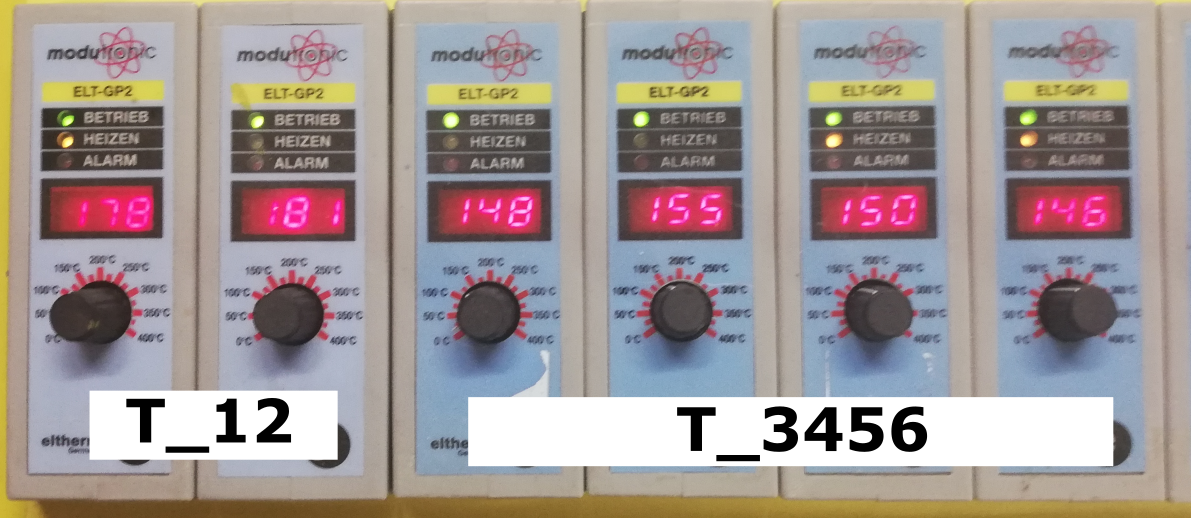
|
|
22
|
Wed Sep 25 13:03:46 2019 |
Laszlo | Analysis | simulations on 118Te+p | |
I have made some simulations at 8AMeV, 7AMeV and 4AMeV energies for the main 118Te + p reaction channels. For the
Rutherford simulations credits to Yuanming! For each energy there are 3 simulations: without the scraper, with the
scraper (online), scraper (online) + E-truncation (offline). The scraper is treated as an "ideal scraper" meaning
that there is no scattering at the edges (maybe worth a GEANT4?). The slit position is at -3cm from the beam, the vertical
length is 7cm (centralized). The following channels are combined in the
simulation:
-8AMeV:
Rutherford
pg channel, 5cascade model. Photon emission is treated isotropically
pn channel, including: -->gs, -->1-->gs, -->2-->gs, -->3-->gs, -->3-->1-->gs, -->4-->1-->gs, -->5-->3-->gs,
-->5-->3-->1-->gs, -->5-->4-->1-->gs decay chains with their weights. Neutron and photon emission is treated isotropically.
-7AMeV:
Rutherford
pg channel, 4cascade model. Photon emission is treated isotropically
-4AMeV:
Rutherford
pg channel, 3cascade model. Photon emission is treated isotropically
The detector position is -2.5cm from the beam in the radial direction and centered vertically with a 45° tilt.
The cross section values for pg and pn, the pn channel mixing, and the pg cascade number is based on TALYS simulations.
The other two input parameters are the luminosity and the measurement time. For the simulation, a little
pessimistic (or realistic?) scenario is taken: L = 10^24 cm-2s-1, and t = 10^4 s. From this values, from the N=CS*L*t
equation, the pg counts (based on the TALYS
cross sections) are the following: 8AMeV ~267, 7AMeV ~163, 4AMeV ~5! This means that to reach the Gamow-window
energies is challenging, but with a well-working scraper it is not impossible to reach.
As it is visible, the 8AMeV 118Te(p,g) case is very similar to the 7AMeV 124Xe case. The p,n threshold is
somewhere ~7.5MeV. |
| Attachment 1: 118Te_cs_energy_line_.png
|
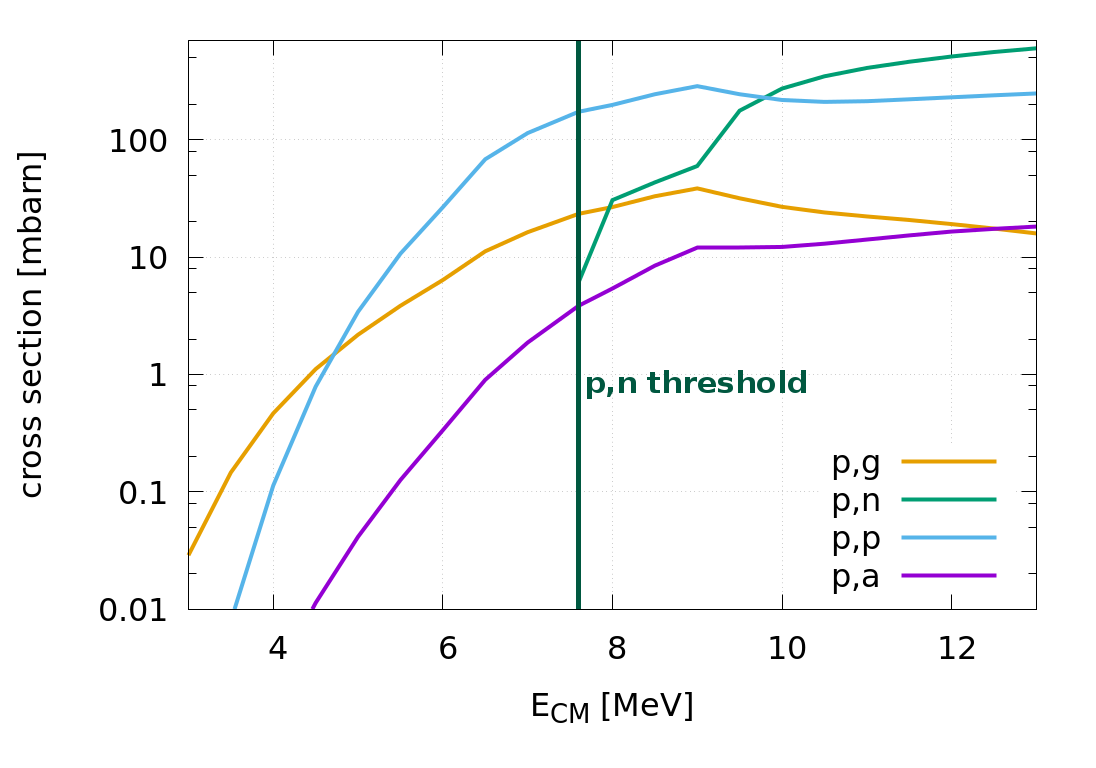
|
| Attachment 2: 8AMeV_combined.png
|
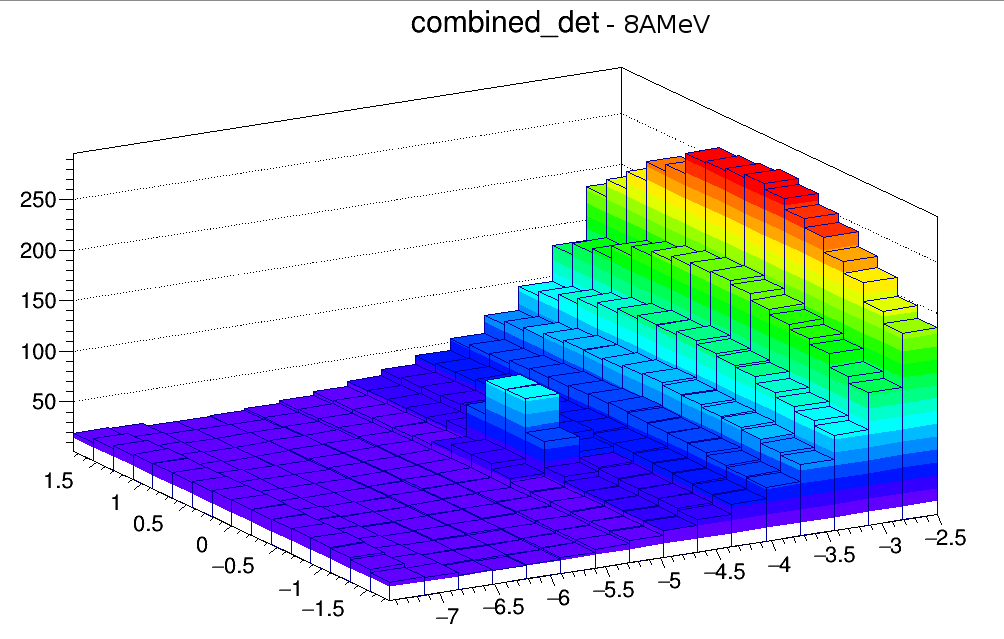
|
| Attachment 3: 8AMeV_combined_spectrum_withoutTruncation.root
|
| Attachment 4: 8AMeV_combined_spectrum_Truncation.root
|
| Attachment 5: 8AMeV_combined_spectrum_ETruncation.root
|
| Attachment 6: 7AMeV_combined_spectrum_withoutTruncation.root
|
| Attachment 7: 7AMeV_combined_spectrum_Truncation.root
|
| Attachment 8: 7AMeV_combined_spectrum_ETruncation.root
|
| Attachment 9: 4AMeV_combined_spectrum_withoutTruncation.root
|
| Attachment 10: 4AMeV_combined_spectrum_Truncation.root
|
| Attachment 11: 4AMeV_combined_spectrum_ETruncation.root
|
|
23
|
Wed Sep 25 13:58:24 2019 |
Laszlo | General | Gamow window energies for 118Te(p,g) | |
# Z A Iso Re Rc T9 upper width mxpos shift
52 118 te118 pg 20 0.5 1.39 0.58 1.06 -0.01
52 118 te118 pg 20 1.0 2.27 1.04 1.69 -0.01
52 118 te118 pg 20 1.5 3.04 1.46 2.21 -0.01
52 118 te118 pg 20 2.0 3.71 1.82 2.68 -0.01
52 118 te118 pg 20 2.5 4.32 2.16 3.10 -0.02
52 118 te118 pg 20 3.0 4.85 2.44 3.47 -0.06
52 118 te118 pg 20 3.5 5.35 2.73 3.79 -0.12
52 118 te118 pg 20 4.0 5.79 2.97 4.08 -0.19
52 118 te118 pg 20 5.0 6.55 3.38 4.61 -0.35
source: https://journals.aps.org/prc/supplemental/10.1103/PhysRevC.81.045807 |
| Attachment 1: PhysRevC.81.045807.pdf
|
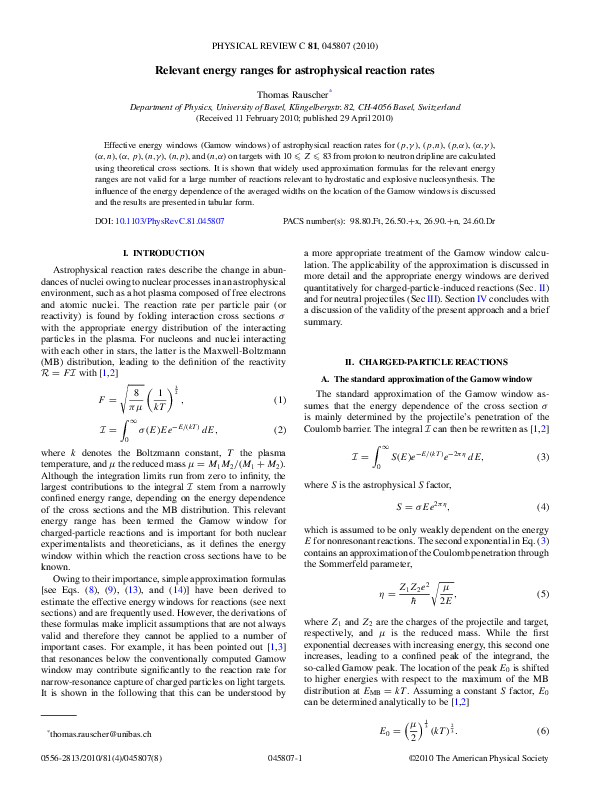
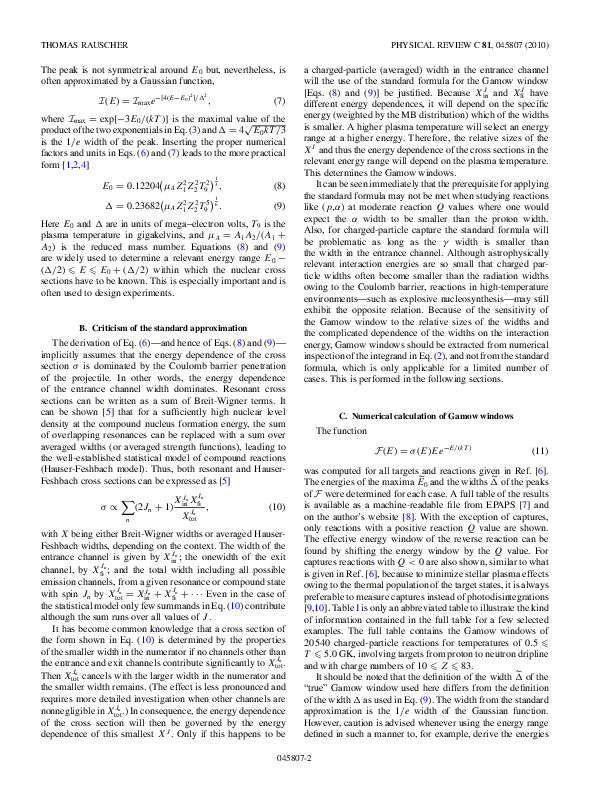
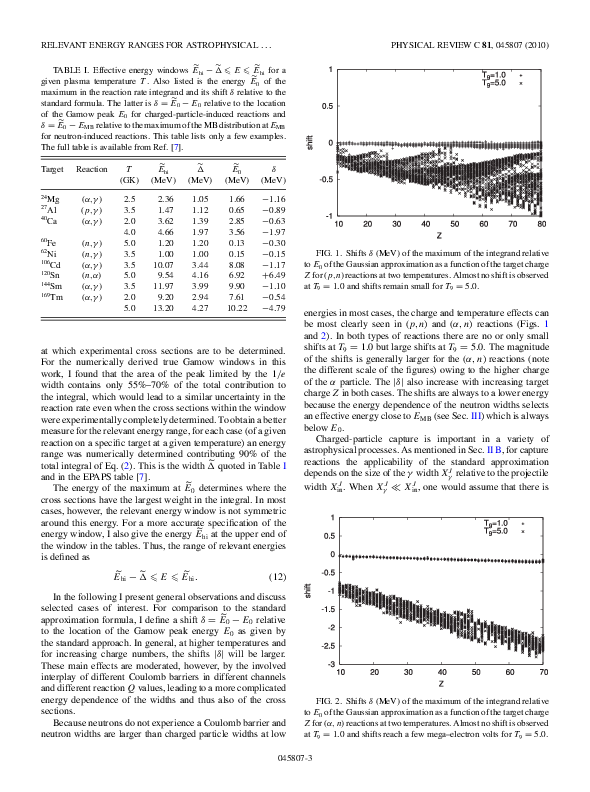
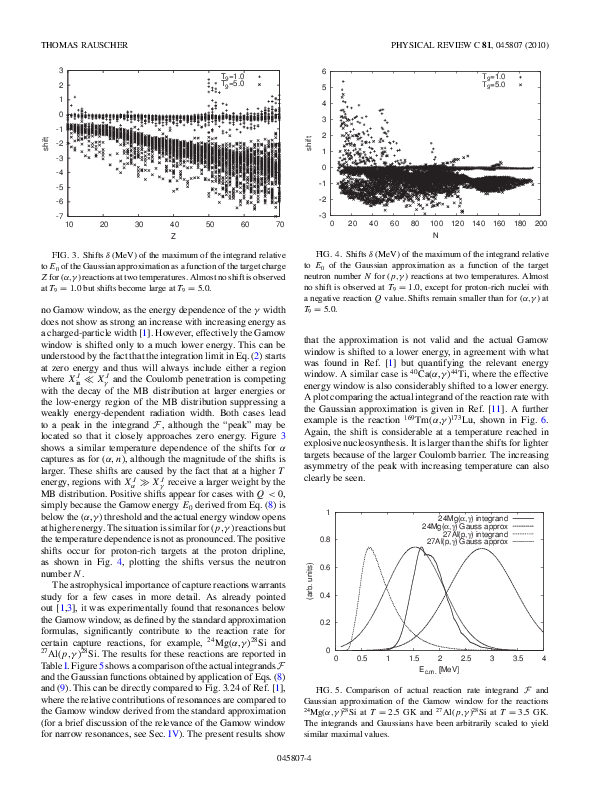
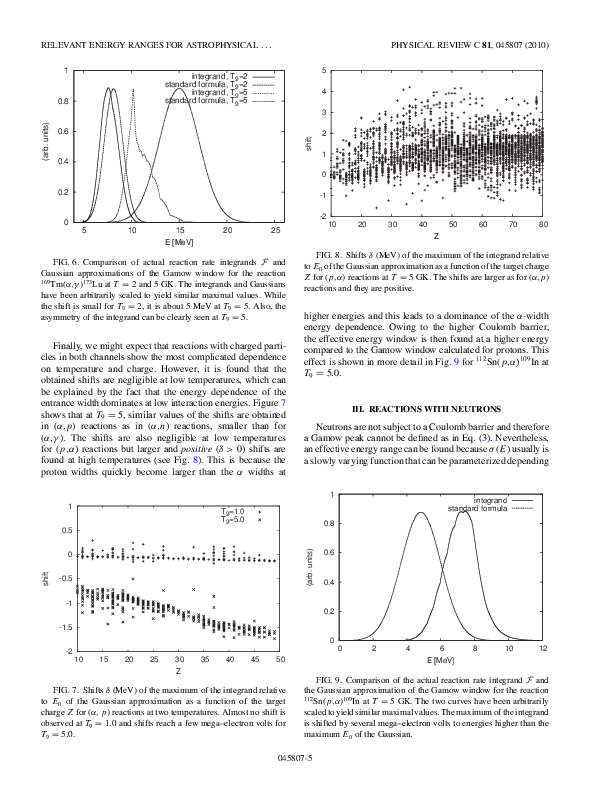

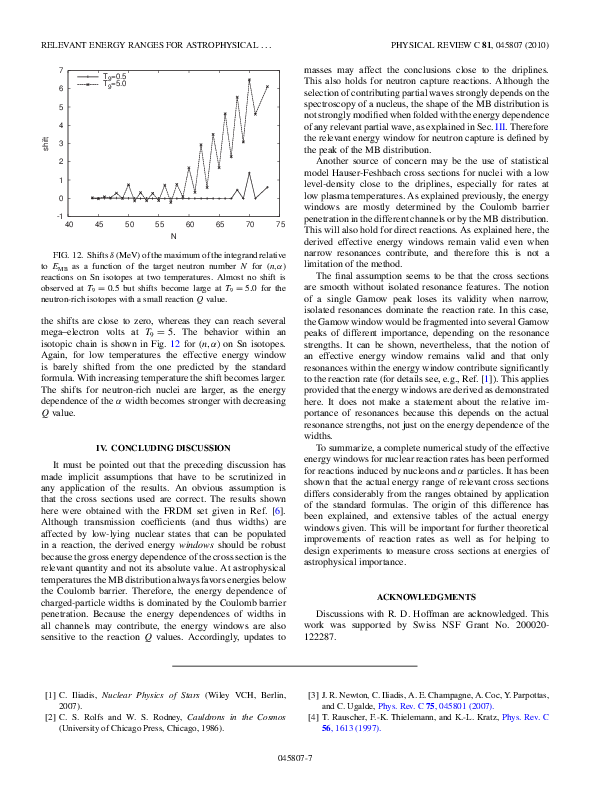

|
|
24
|
Wed Oct 23 11:40:29 2019 |
Jan | Runs | prerun005 - MixedAlpha | |
save point: lxg1275:/datalocal1/e127/predata/prerun005
start: 23.10.19 - 11:40
stopp: 23.10.19 - ~13:30
DAQ setup:
32 ADC channels
ch. 1-16 (section 0) >> x-strips
ch. 17-32 (section1) >> y-strips
32 TDC channels
ch. 1-16 (section 0) >> x-strips
ch. 17-32 (section1) >> y-strips
32 scaler channels
(not used)
Detector setup:
bias -30V
MixedAlpha source in center |
|
25
|
Wed Oct 23 14:51:43 2019 |
Jan, Laszlo | DAQ | VME modules & main.cfg | |
Here is the current list of VME modules in our DRASI daq including HW addresses:
Slot <module> [HW addr.]
1 <RIO4>
2 <Vulom4b> [0500]
3 <ENV3>
5 <scaler V830> [00E1]
7 <scaler V830> [00E2]
15 <TDC V775> [00C1]
17 <TDC V775> [00C2]
19 <MADC> [00A1]
21 <MADC> [00A2]
See also main.cfg attached |
| Attachment 1: main.cfg
|
CRATE("Master")
{
GSI_VULOM(0x05000000) {
trlo2_master = true
}
MESYTEC_MADC32(0x00A10000) {
nim_busy = gate0
range = 10 V
resolution=8
hires=true
}
BARRIER
MESYTEC_MADC32(0x00A20000) {
nim_busy = gate0
range = 10 V
resolution=8
hires=true
}
BARRIER
CAEN_V775 (0x00C10000) {
common_start = false
time_range = 1200 ns
suppress_invalid = true
suppress_over_range = true
}
BARRIER
CAEN_V775 (0x00C20000) {
common_start = false
time_range = 1200 ns
suppress_invalid = true
suppress_over_range = true
}
BARRIER
CAEN_V830 (0x00E10000) {
resolution = 32
}
BARRIER
CAEN_V830 (0x00E20000) {
resolution = 32
}
}
|
|
26
|
Wed Oct 23 15:35:29 2019 |
Jan | DAQ | DAQ with & without MDPP-16 | |
the DAQ located in
../esrdaq_2018/r4l-58_dev/
currently includes
2x MADC
2x Caen V775 TDC
2x Caen V830 Scaler
> The DAQ located in
>
> ../esrdaq_2018/r4l-58/
> currently includes the readout of
> MADC
> Caen 775 TDC
> Caen 830 Scaler
> MDPP-16
>
> ../esrdaq_2018/r4l-58_rewind/
> is without the MDPP-16:
> MADC
> Caen 775 TDC
> Caen 830 Scaler |
|
27
|
Fri Oct 25 16:34:51 2019 |
Jan | Runs | prerun007 - MixedAlpha | |
save point: lxg1275:/datalocal1/e127/predata/prerun007
start: Fr 25.10.19 - 16:35
stopp:
DAQ setup:
64 ADC channels
ch. 01-64 (ADC0) >> empty
ch. 33-48 (ADC1 - section0) >> x-strips
ch. 49-64 (ADC1 - section1) >> y-strips
32 TDC channels
ch. 01-64 (TDC0) >> empty
ch. 33-48 (TDC1 - section0) >> x-strips
ch. 49-64 (TDC1 - section1) >> y-strips
64 scaler channels
(not used)
Detector setup:
bias -30V
MixedAlpha source in center |
|
28
|
Wed Nov 6 14:13:53 2019 |
Jan, Laszlo | Detectors | DSSSD - 1st movement - realignment | |
We moved the new detector installation for the first time slowly into the dipole chamber.
The alignement seems to be pefect, no distortion or vertical movement of the detector-arm was observed from the window flange.
The vacuum on the detector side went up from 2e-10 mbar to about 5e-9 mbar.
On the ring side it was 3e-11 mbar befor and 1e-10 mbar after movement.
The extreme positions possible (Endlage) are:
max out: -10613
max in: -7
These are the absolute positions in units of 0.1 mm
It has to be noted that after bakeout a realignment of the detector was needed in order to have it centered in vertical dimension. However, this realignment has been only slight turns of the base flange alignment screws. In detail, the two inner "Sechskantschrauben" below the bellow have been loosed slightly, while the outer two have been tightend. Additionally, the small "Madenschraube" on the outside has been loosend by 1/4 turn.
In result the detector could be raised in vertical position by about ~5mm (jugded by eye).
The effect of small turning on the screws is extreme on the detector position! Be careful when re-adjusting. |
|
29
|
Fri Nov 15 10:46:12 2019 |
Laszlo | Detectors | Detector movement from HKR | |
To move the detector remotely from the HKR:
-go to a desktop of a HKR computer
-right click: "App Launcher PRO"
(-you have to give some password at this point?)
-within the program go to "Development->ProHelper"
-write the name of our slow control unit in the field Nomen: "GE01DD4AS"
-There are 4rows, the middle two called: "Read props", "Write props"
-In "Read props" open "rposiabss" -> if you hit here the refresh button it will show only the SET position
-In "Read props" open "rposiabsi" -> if you hit here the refresh button it will show the REAL-TIME position of the detector
-In "Write props" open "wposiabss" -> here you can set the absolute position of our detector (one click is already enough to execute the command).
most OUT of the ring position: -10613 [0.1mm] in absolute
most IN into the ring position: -7 [0.1mm] in absolute
The value can have as big step size as we want contrary to relative movement, when you are limited to something like 20cm.
To close the program just simply hit the "x" buttons. |
| Attachment 1: IMG_20191114_135600.jpg
|
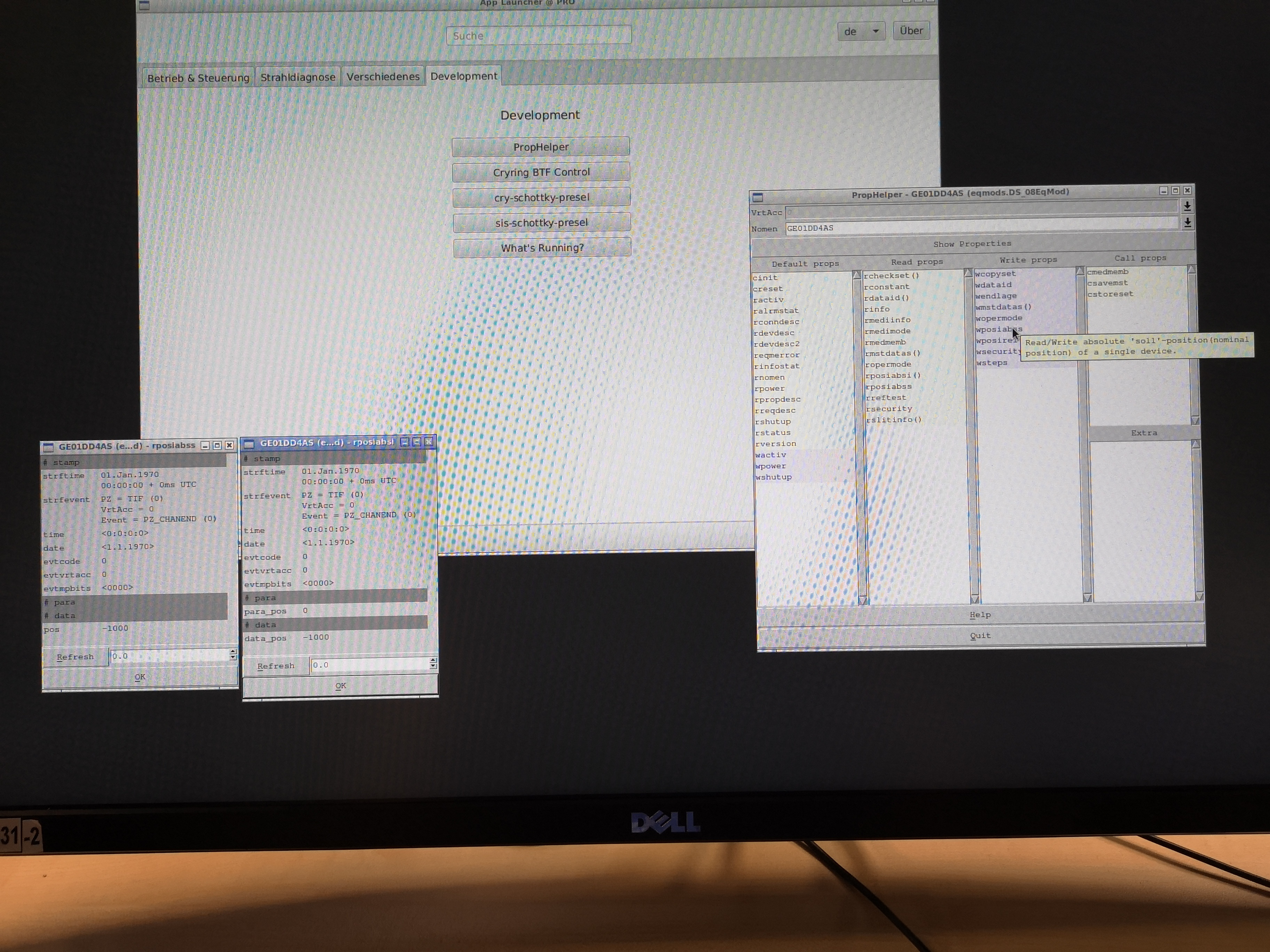
|
|
30
|
Thu Dec 5 10:57:57 2019 |
Jan, Laszlo | Detectors | setting up the DSSD with beam | |
This is a brief how-to about getting the DSSSD set up with stored beam and target in the ESR.
The main goals
1. adjust timing signals to TDC-range
2. adjust energy signals to ADC-range
3. optimize energy resolution
The signal chain is the following:
det [32ch.] > preamp [2x16ch] > 2x MSCF shapers [16ch] |
|
31
|
Thu Jan 23 16:35:47 2020 |
Laszlo | DAQ | cable documentation | |
|
| Attachment 1: cable_documentation_e127.pdf
|

|
| Attachment 2: cable_documentation_e127.ods
|
|
32
|
Tue Feb 11 13:20:01 2020 |
Jan | Detectors | BaF2 - HV settings | |
with these HV values the 6 channels are roughly gain matched, such that the 7.83 MeV Po-decay is around channel 5000. |
| Attachment 1: BaF2_HV_settings.png
|

|
| Attachment 2: baf_bg_ch1.png
|
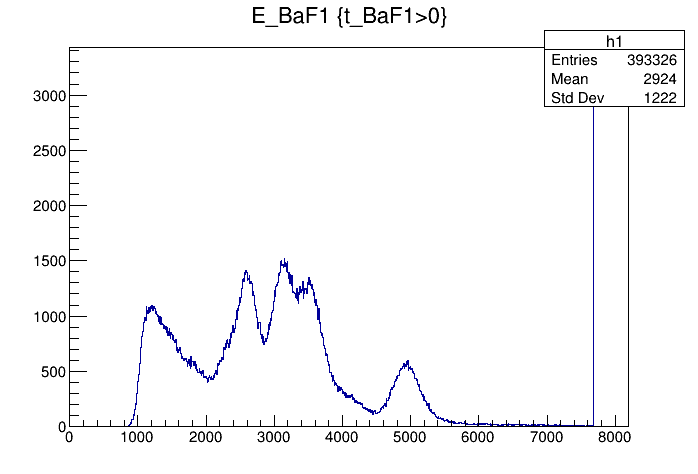
|
|
33
|
Mon Feb 17 08:14:44 2020 |
Jan | Simulations | 118Te K-REC X-ray energies | |
X-ray energies of K-REC for 118Te according to
http://www-ap.gsi.de/Thomas/ap_html_research/energy/index.php
|
parameters | 35 deg | 90 deg | 145 deg
| |
8 MeV/u | 47.29 keV | 42.25 keV | 38.17 keV
| |
5 MeV/u | 44.51 keV | 40.74 keV | 37.57 keV
|
Full results are attached |
| Attachment 1: Photonen_Kammer.png
|
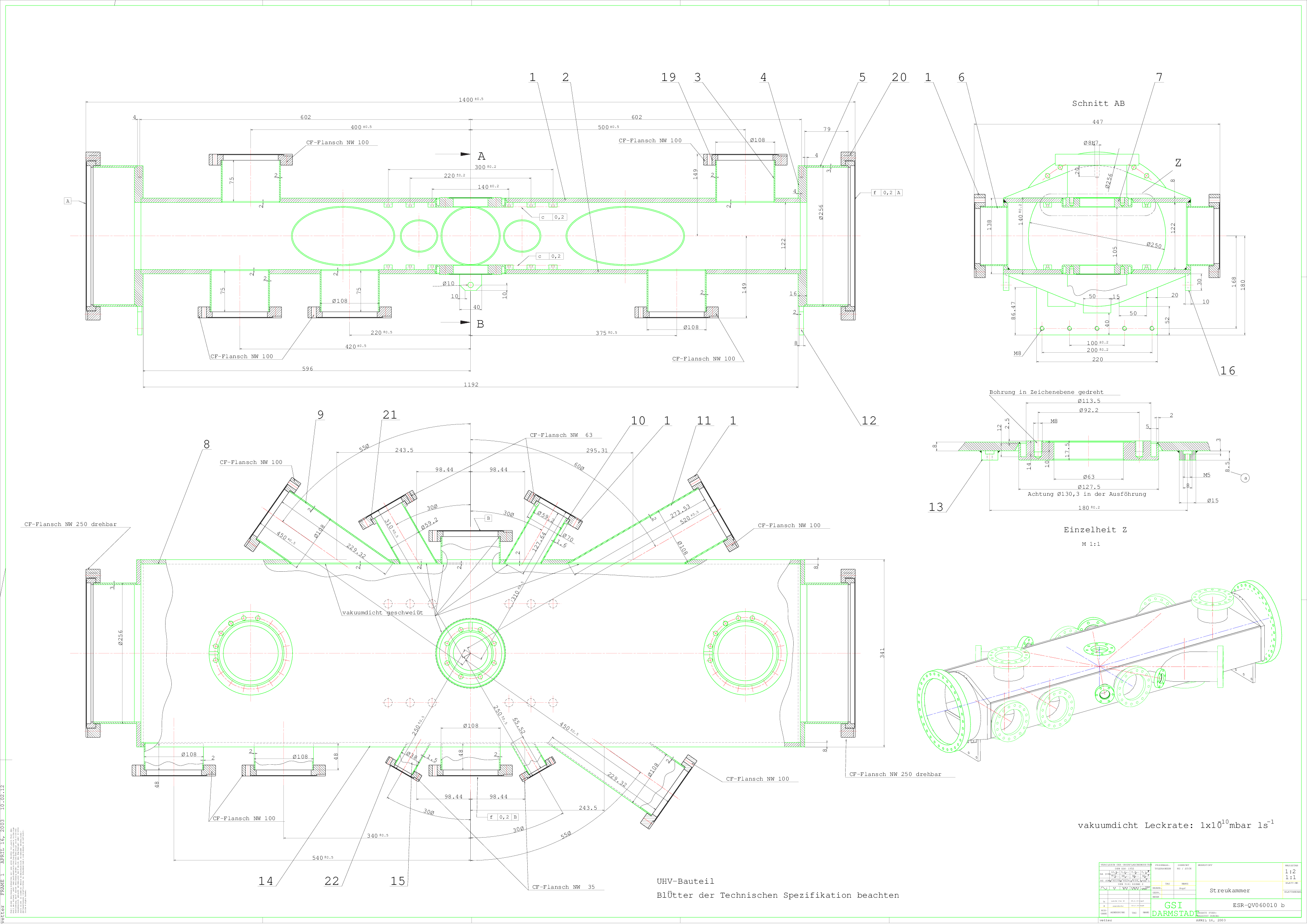
|
| Attachment 2: x-ray_calculator.txt
|
##################
8 MeV/U - 90 deg
******************* KINEMATICS ****** *****************
ZPROJ..........................:= 52.
THETA..........................:= 90.
EKIN(MeV/U)....................:= 8.
KINETIC ELECTRON ENERGY (keV)..:= 4.38864217
V (A.U.).......................:= 17.8451164
BETA...........................:= 0.130222112
GAMMA..........................:= 1.00858828
DOPPLER SHIFT..................:= 0.991491303
SOLID ANGLE TR LAB/CM..........:= 0.983055003
EMISSION ANGLE IN EMITTER-FRAME:= 97.4826901
******************* ENERGIES IN KEV ****** ************
ETA...(v/Zp)^2.................:= 0.117769298
ETA..(ENERGY)..................:= 0.114827573
EK(BIND).......................:= 38.2193878
EL(BIND).......................:= 9.28182715
EM(BIND).......................:= 4.10427342
K-ALPHA (LAB.).................:= 28.6913397
K-BETA (LAB.).................:= 33.8248391
L-ALPHA (LAB.).................:= 5.13349949
KINETIC ELEC. ENERGY (LAB.)....:= 4.35130054
E K-REC (LAB)..................:= 42.2454911
E L-REC (LAB)..................:= 13.5541514
E M-REC (LAB)..................:= 8.42065194
##################
8 MeV/U - 35 deg
******************* KINEMATICS ****** *****************
ZPROJ..........................:= 52.
THETA..........................:= 35.
EKIN(MeV/U)....................:= 8.
KINETIC ELECTRON ENERGY (keV)..:= 4.38864217
V (A.U.).......................:= 17.8451164
BETA...........................:= 0.130222112
GAMMA..........................:= 1.00858828
DOPPLER SHIFT..................:= 1.10987917
SOLID ANGLE TR LAB/CM..........:= 1.23183176
EMISSION ANGLE IN EMITTER-FRAME:= 39.5387398
******************* ENERGIES IN KEV ****** ************
ETA...(v/Zp)^2.................:= 0.117769298
ETA..(ENERGY)..................:= 0.114827573
EK(BIND).......................:= 38.2193878
EL(BIND).......................:= 9.28182715
EM(BIND).......................:= 4.10427342
K-ALPHA (LAB.).................:= 32.1171956
K-BETA (LAB.).................:= 37.8636547
L-ALPHA (LAB.).................:= 5.74645901
KINETIC ELEC. ENERGY (LAB.)....:= 4.87086251
E K-REC (LAB)..................:= 47.2897647
E L-REC (LAB)..................:= 15.1725691
E M-REC (LAB)..................:= 9.42611007
##################
8 MeV/U - 145 deg
******************* KINEMATICS ****** *****************
ZPROJ..........................:= 52.
THETA..........................:= 145.
EKIN(MeV/U)....................:= 8.
KINETIC ELECTRON ENERGY (keV)..:= 4.38864217
V (A.U.).......................:= 17.8451164
BETA...........................:= 0.130222112
GAMMA..........................:= 1.00858828
DOPPLER SHIFT..................:= 0.895920831
SOLID ANGLE TR LAB/CM..........:= 0.802674136
EMISSION ANGLE IN EMITTER-FRAME:= 149.078236
******************* ENERGIES IN KEV ****** ************
ETA...(v/Zp)^2.................:= 0.117769298
ETA..(ENERGY)..................:= 0.114827573
EK(BIND).......................:= 38.2193878
EL(BIND).......................:= 9.28182715
EM(BIND).......................:= 4.10427342
K-ALPHA (LAB.).................:= 25.9257634
K-BETA (LAB.).................:= 30.5644416
L-ALPHA (LAB.).................:= 4.63867824
KINETIC ELEC. ENERGY (LAB.)....:= 3.93187594
E K-REC (LAB)..................:= 38.1734216
E L-REC (LAB)..................:= 12.2476582
E M-REC (LAB)..................:= 7.60898
##################
5 MeV/U - 90 deg
******************* KINEMATICS ****** *****************
ZPROJ..........................:= 52.
THETA..........................:= 90.
EKIN(MeV/U)....................:= 5.
KINETIC ELECTRON ENERGY (keV)..:= 2.74290135
V (A.U.).......................:= 14.1416452
BETA...........................:= 0.103196576
GAMMA..........................:= 1.00536768
DOPPLER SHIFT..................:= 0.994666113
SOLID ANGLE TR LAB/CM..........:= 0.989360677
EMISSION ANGLE IN EMITTER-FRAME:= 95.9234773
******************* ENERGIES IN KEV ****** ************
ETA...(v/Zp)^2.................:= 0.0739593675
ETA..(ENERGY)..................:= 0.0717672332
EK(BIND).......................:= 38.2193878
EL(BIND).......................:= 9.28182715
EM(BIND).......................:= 4.10427342
K-ALPHA (LAB.).................:= 28.7832109
K-BETA (LAB.).................:= 33.9331482
L-ALPHA (LAB.).................:= 5.14993724
KINETIC ELEC. ENERGY (LAB.)....:= 2.72827103
E K-REC (LAB)..................:= 40.7438009
E L-REC (LAB)..................:= 11.96059
E M-REC (LAB)..................:= 6.81065272
##################
5 MeV/U - 35 deg
******************* KINEMATICS ****** *****************
ZPROJ..........................:= 52.
THETA..........................:= 35.
EKIN(MeV/U)....................:= 5.
KINETIC ELECTRON ENERGY (keV)..:= 2.74290135
V (A.U.).......................:= 14.1416452
BETA...........................:= 0.103196576
GAMMA..........................:= 1.00536768
DOPPLER SHIFT..................:= 1.08650883
SOLID ANGLE TR LAB/CM..........:= 1.18050143
EMISSION ANGLE IN EMITTER-FRAME:= 38.5498499
******************* ENERGIES IN KEV ****** ************
ETA...(v/Zp)^2.................:= 0.0739593675
ETA..(ENERGY)..................:= 0.0717672332
EK(BIND).......................:= 38.2193878
EL(BIND).......................:= 9.28182715
EM(BIND).......................:= 4.10427342
K-ALPHA (LAB.).................:= 31.440915
K-BETA (LAB.).................:= 37.0663729
L-ALPHA (LAB.).................:= 5.62545782
KINETIC ELEC. ENERGY (LAB.)....:= 2.98018653
E K-REC (LAB)..................:= 44.5058887
E L-REC (LAB)..................:= 13.0649737
E M-REC (LAB)..................:= 7.43951584
##################
5 MeV/U - 145 deg
******************* KINEMATICS ****** *****************
ZPROJ..........................:= 52.
THETA..........................:= 145.
EKIN(MeV/U)....................:= 5.
KINETIC ELECTRON ENERGY (keV)..:= 2.74290135
V (A.U.).......................:= 14.1416452
BETA...........................:= 0.103196576
GAMMA..........................:= 1.00536768
DOPPLER SHIFT..................:= 0.917136431
SOLID ANGLE TR LAB/CM..........:= 0.841139233
EMISSION ANGLE IN EMITTER-FRAME:= 148.261832
******************* ENERGIES IN KEV ****** ************
ETA...(v/Zp)^2.................:= 0.0739593675
ETA..(ENERGY)..................:= 0.0717672332
EK(BIND).......................:= 38.2193878
EL(BIND).......................:= 9.28182715
EM(BIND).......................:= 4.10427342
K-ALPHA (LAB.).................:= 26.5396911
K-BETA (LAB.).................:= 31.2882142
L-ALPHA (LAB.).................:= 4.74852314
KINETIC ELEC. ENERGY (LAB.)....:= 2.51561476
E K-REC (LAB)..................:= 37.5680076
E L-REC (LAB)..................:= 11.0283166
E M-REC (LAB)..................:= 6.27979344
|
|
34
|
Fri Feb 21 09:39:40 2020 |
Laszlo | DAQ | cable documentation | |
|
| Attachment 1: cable_documentation_e127.pdf
|

|
| Attachment 2: cable_documentation_e127.ods
|
|
35
|
Fri Feb 21 11:29:02 2020 |
Laszlo | General | Shift plan | |
https://docs.google.com/spreadsheets/d/14m8WcCq1erx6HqWJRK7TLbCx121IkjqGa5l-frf4YjI/edit#gid=0 |
|
36
|
Fri Feb 21 11:29:59 2020 |
Jan | Detectors | det. distances at target chamber | |
This is the lookup table for the distance of each x-ray detector to the target.
See attched foto for explanation.
|
Detector | A (dA) [mm] | B (dB) [mm] | C (dC) [mm] | calculate | result [mm]
| |
35° | 136.0 (1.0) | 20.0 (0.2) | 450.0 (0.5) | C + B - A | 334.0 (?)
| |
90° | 76.0 (0.5) | 20.0 (0.2) | 447.0/2 = 223.5 (1.0) | C + B - A | 167.5 (?)
| |
145° | 165.0 (1.0) | 20.0 (0.2) | 450.0 (0.5) | C + B - A | 305.0 (?)
|
Errors are estimated after measurement, final errorbars have to be double checked! |
| Attachment 1: Photonen_Kammer.png
|

|
|
37
|
Tue Mar 10 08:52:34 2020 |
Jan | Detectors | DSSSD positioning | |
To find a good Si position, we need to follow a procedure similar to this:
1. Si in max-in position
2. find distance of beam by scraping with detector from inside
--> zero position
3. from this zero, we need to set a distance of about 1.5 cm to the inside (as shown in the sketch below)
It is likely that this position is not compatible with the complete ESR cycle (e.g. we scrape beam with det. during deceleration).
The solution is to move the beam closer to the detector after deceleration. There are two feasible methods to do this:
A. make a local bump in the dipole
--> check new zero and det. position again, as sketched above
--> in 2016 this method didn't allow to go close enough to the detector, eventually we used:
B. global orbit change (by magnet ramp) + target bump (to keep overlap)
--> this takes a bit more time to set up and also the cycle will be longer at low energies (critical due to life-time)
--> method A is preferred, but might not be strong enough
This needs to be checked and repeated for each new beam setting. |
| Attachment 1: optimum_detector_position_2.jpg
|
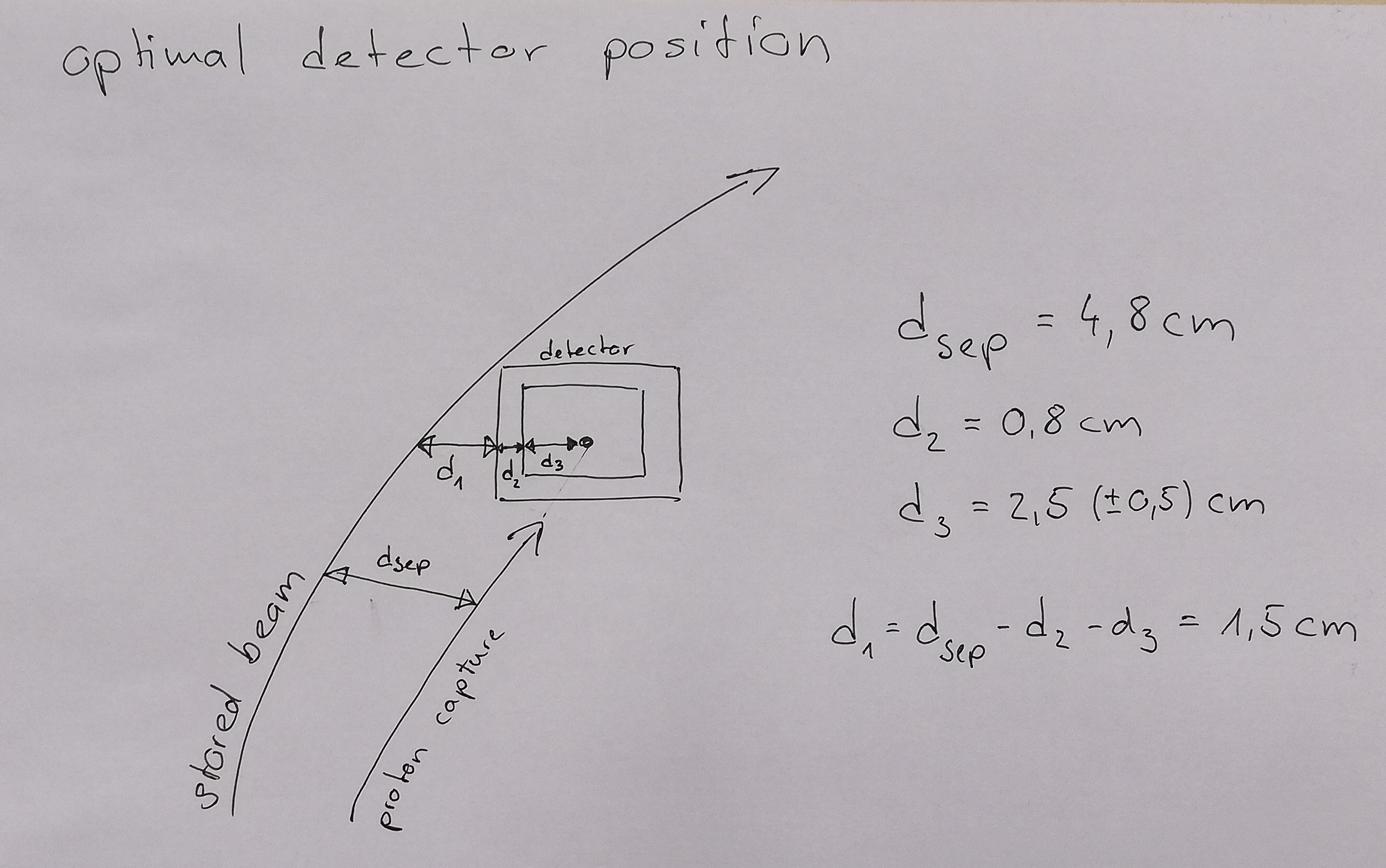
|
|
38
|
Tue Mar 10 09:41:26 2020 |
Jan | Detectors | x-ray background from BaF | |
The BaF2 detectors planned to be installed at the target induce an additional background in the x-ray detectors sitting below inside the target chamber.
We made test measurements with an x-ray detector for estimating the background in the region of interest for our K-REC measurements (35 to 50 keV).
For the interval [35-50 keV]:
Normal background level: 0.065 (s*keV)^-1
BaF2 in 5cm distance: 0.078 (s*keV)^-1
This is an increase by about 22%
Assuming an increase by 100% induced by 6 BaF2 in the vincinity of the Ge-detectors this seems acceptable.
However additional BaF-induced peaks are also visible at ~30 keV and ~60 keV. While these are not in the region of interest for the K-REC, we need to be aware of them!
spectra are available on the Frankfurt exp-astro Server at /home/glorius/e127/ |
|
39
|
Wed Mar 11 09:08:21 2020 |
Jan | DAQ | DAQ & controls - OVERVIEW | |
For all DAQ & slow control buissines the user
litv-exp
is used with the password ViValasVegas1964
Here is a list of computers and devices we use for the current DAQ:
- r4l-58 - VME cpu (RIO)
our DAQ runs on this computer
access from lxg1275 via ssh litv-exp@r4l-58
the current DAQ directory is /esr/usr/litv-exp/2020_e127/r4l-58
from lxg-machines the DAQ dir can also be accessed via the mount point at /lynx/Lynx/esr/usr/litv-exp/2020_e127/r4l-58
- lxg1275 - main DAQ handler
used for communication with the DAQ and primary data writing/streaming
access from any lxg via ssh litv-exp@lxg1275
primary data folder: /data.local3/e127/lmd/
local backup folder: /data.local2/e127/lmd_backup/
- lxg1299 - online monitoring
used for the R3Broot online monitor server
access from any lxg via ssh litv-exp@lxg1299
online data: /data.local3/e127/online/
- atpnu004 - slow control
used for remote access to SpecAmps (MesyTec Shapers), Si-HV (caen) and picoscopes
access from any lxg via E127_nuc or ssh litv-exp@atpnuc004
screen sessions: mesy_ioc (shapers), caen_ioc (Si HV)
access screens by screen -x mesy_ioc or screen -x caen_ioc (exit with [Ctrl-a d])
access vnc session for picoscopes on any lxg: E127_vnc or vncviewer atpnuc004:1
- apraspi001 - slow control 2
used for remote access to the BaF HV crate
access from any lxg via ssh litv-exp@apraspi001
local access to HV control by telnet: telnet 169.254.93.160 1527
- lxg0188 - 1st backup node
used for direct backup of the written data (invoked automatically by stopping a run)
backup dir: /data.local2/E127_lmd/
- kronos.hpc.gsi.de - 2nd backup node
used for secondary backup of lmd-data on lxg0188 (chronjob every 4 hours)
backup dir: /lustre/ap/litv-exp/2020-03-17_E127_jglorius
List of commands and aliases
- E127_daq or /data.local1/e127/scripts/E127_start_gui.sh
this is the GUI to control the DAQ
available on lxg1275 only with litv-exp user
only one instance of this GUI can run at the same time!
- E127_unpack or /u/litv-exp/unpacker/unpackexps/e127/e127
this is the unpacker for the current DAQ
available on any lxg with litv-exp user
to unpack lmd-files to root-file: E127_unpack infile01.lmd infile02.lmd --ntuple=RAW,outfile.root
- E127_epics or epicsfind; medm -x /u/litv-exp/e127/medm/e127.adl
this is the GUI for slow control of Si HV and amplifiers (MesyTec Shapers)
available on any lxg with litv-exp user
- E127_rates or /u/litv-exp/e127/UDP/build_cc_x86_64-linux-gnu_4.9.2_debug/udp_reader --trig --rate
this is the UDP reader for detector and trigger rates
available on lxg1275 only with litv-exp user
|
|
40
|
Wed Mar 11 14:33:44 2020 |
Laszlo | General | beam time manual | |
Here you can find the digital version of the E127 beam time manual. |
| Attachment 1: E127_experimental_manual.pdf
|

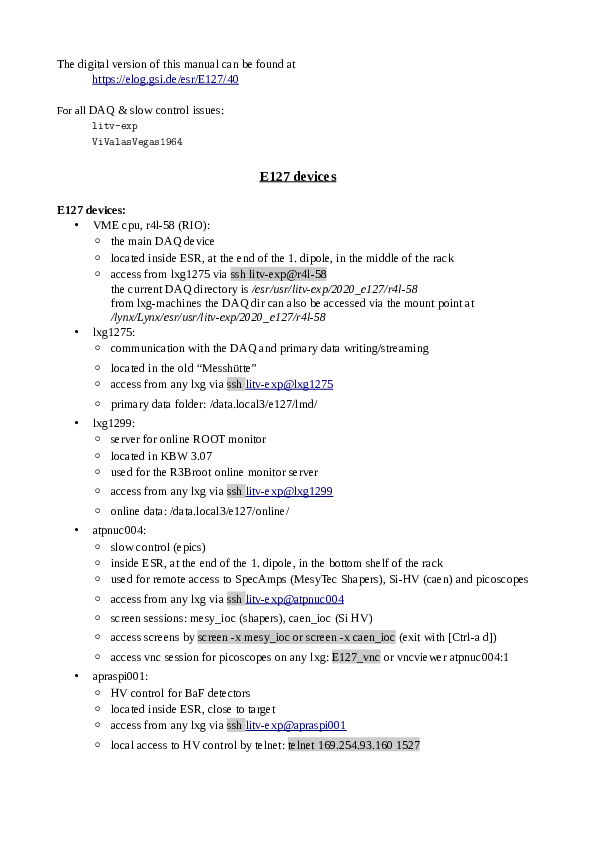



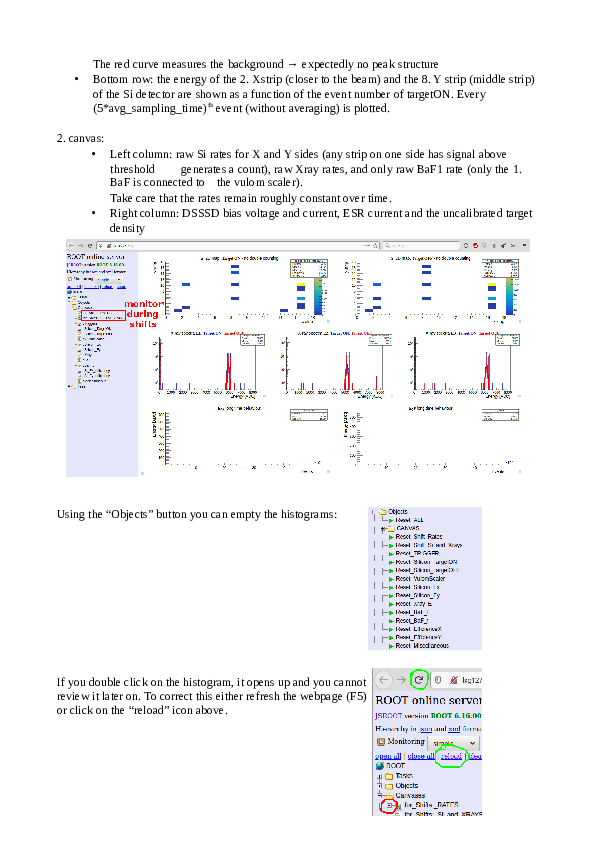
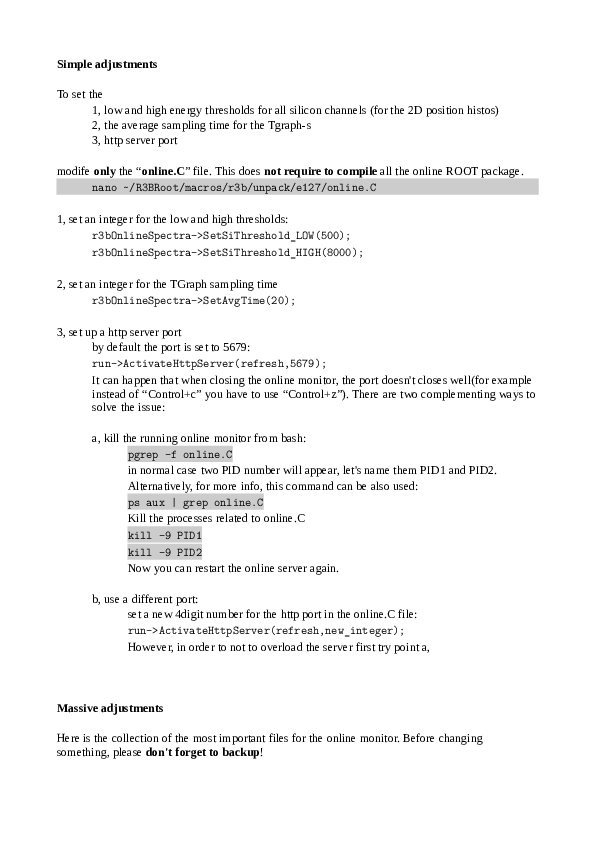
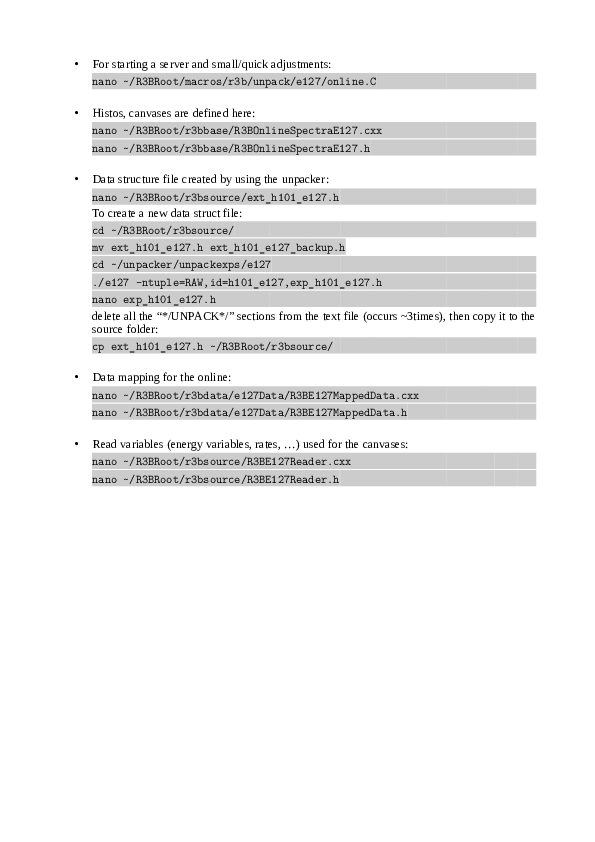
|
| Attachment 2: manual.odt
|